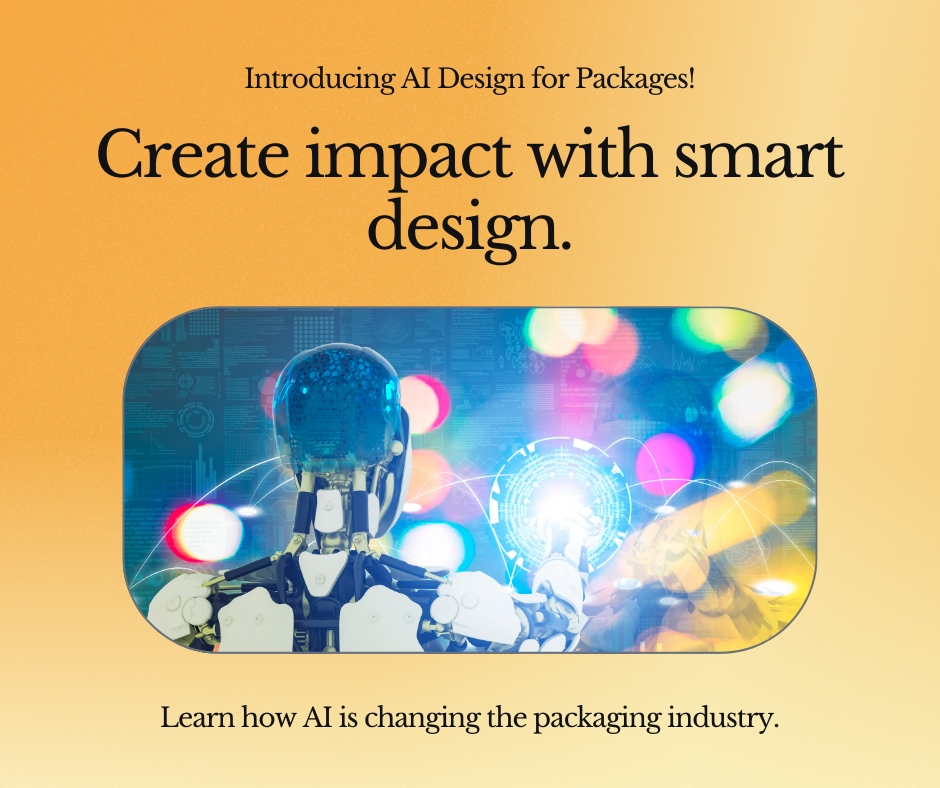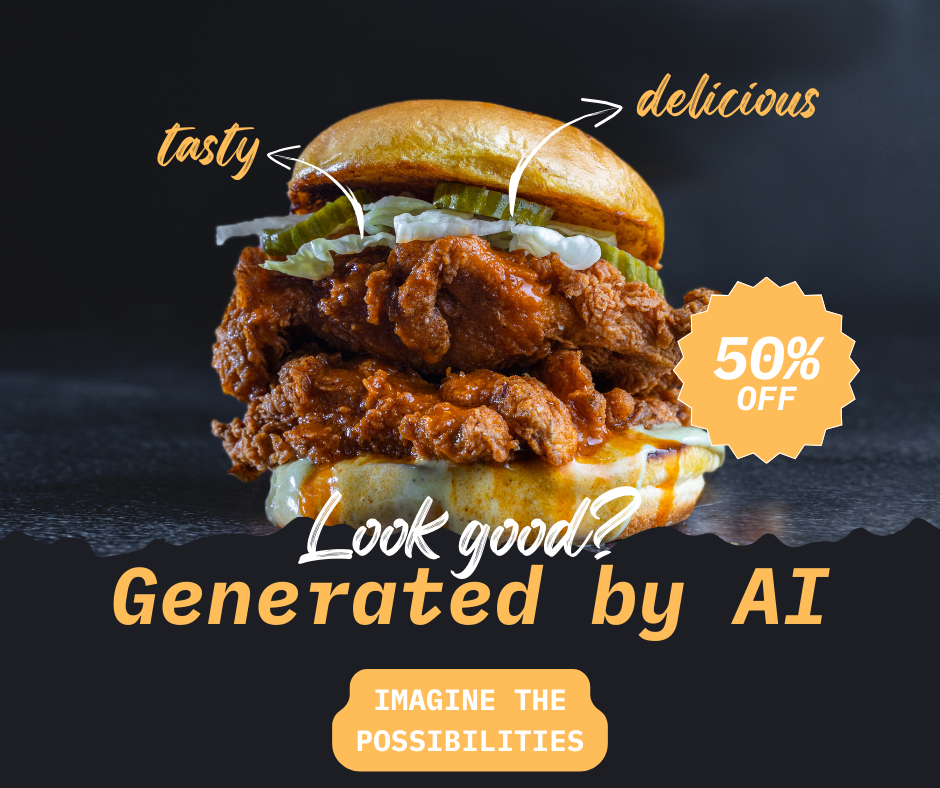Artificial Intelligence (AI) is showing up daily – in conversation, in the news and in our workspaces. For the packaging industry, AI paired with other technologies such as digital printing and IoT has the potential to optimize operational processes, reshape business models and transform the customer experience. Read on to learn about the potential impact of AI on packaging from design to consumer experience to recycling.

Image created with AI.
Potential Benefits of AI
Graphic Design
What if the ideal design could be developed and approved within 24 hours? AI is being used to go from text to image in a matter of seconds. The resulting image can be further refined and save a traditional graphic designer a lot of time in generating different concepts for clients to view. Edits can be done very quickly. AB testing with variable design changes? No problem. Integrate the AI designed graphics with digital printing, and you can execute very quickly. Infigo launched its web-to-print specialist AI in 2023. MegaEdit, an online product designer, enables parametric design whereby three-dimensional product features on packaging products can be shaped according to algorithmic processes rather than created by a designer. IT’s an innovation specifically designed for the web-to-packaging industry saving printers the hassle of having to program their own GPT.

Image created with AI; it can easily be customized speeding the graphic design process.
A New Customer Experience
Dragonfly AI goes beyond graphic design to bring about a different customer experience. AI is utilized to tailor packaging to specific groups of customers based on their preferences. The AI tool uses data to predict which elements and colors will draw a consumer in and where those elements will be placed. Using unique QR codes, the package can now be scanned, and information shared. Does your customer want to know the integrity of the supply chain? You can communicate it. Does the customer want to verify product authenticity. Done. Has the item sat on the shelf longer than you want? The integrated systems can generate special offers when a consumer scans the pack to get it sold. AI can analyze the data coming back and predict the most successful promotions to help items sell faster. IoT-enabled smart packages can alert consumers and/or businesses when stock levels are low. If the data is communicated back to the manufacturer, AI can analyze this data and suggest future order quantities and re-order time frames to help customers ensure they have product when they need it.
Sustainability Through Increased Efficiency
The packaging industry faces continuing sustainability pressures. How can we be more recyclable? How can we integrate human, animal and environmentally friendly chemistry into packaging solutions that also protect the products inside? Chemists and synthesis scientists process a tremendous amount of data generated from many experiments over time. AI has the potential to aid scientists in the analysis of data available within their companies. Suddenly, a scientific breakthrough is not reliant on one individual in one lab, but rather the culmination of research and what that research means. AI can help us spot trends. These trends have the potential to be used to identify chemistries with the least environmental impact that also provide performance. Scientists can take the data and apply it to accelerate the process of developing formulations that can change packaging materials, adhesives, and inks. Imagine what it would do for the world if a major discovery can be accelerated 1 year, 5 years, or 20 years because of efficiencies in AI data analysis. What if food could stay fresher longer?
What if the printing could be customized so that every package has a custom QR code. And what if the information the QR code linked to could change based on real world circumstances? Perhaps the consumer would get a message upon scanning the QR code that would change over time – a promotion when on the store shelf, confirmation of authenticity, tracing the supply chain, or freshness updates. And then, the consumer puts the used package in the recycling. Perhaps the recycler can scan that same QR code and get information as to the make up of the package to make sorting more efficient. What if efficiencies in the recycling chain could lower the cost to recycle? Could recycling plastic packaging become more mainstream, more viable, more affordable by integrating AI with other technologies to create a more efficient and sustainable system from cradle to grave?
Digital printing, AI and digital cutting process could also be integrated to impact sustainability by digitizing the entire print and cut process. This could minimize material waste. It could also minimize production time. AI can inform the optimal layouts and cut lines of the print to minimize material waste. Digital printing can be leveraged to print the layouts and cut line indicators in different positions. Digital cutting equipment can then recognize the printed indicators to efficiently cut the material where desired.
Considerations for Implementing AI Solutions
Identify Business Goals and AI’s Role as a Solution
To ensure AI is the right solution to solve your organization’s nuanced challenges, it’s important to start with the end in mind. What are your business goals? In what time frame do you wish to deliver on these goals? What are the different ways you can achieve these goals? Is AI as a solution the efficient way to help you accelerate delivery of your goals? If yes, proceed. If not, AI might not be the right solution for your organization at this time. Select a goal where AI is the right tool to get the results you seek.
Data Quality and Readiness
AI models rely heavily on data. If you want to optimize your processes, you’ll need to load your data into the model. As the saying goes, junk in equals junk out. To maximize the benefit of AI, you’ll need to ensure the data exists, you have enough of it and then that the data is clean and usable.
Technical Infrastructure
Can your current technical infrastructure support AI integration? Ensure your IT team is brought in early to lead this evaluation. AI models rely on data and then need to be backed with the computational power to assess that data. If you don’t have that computational power, you’ll need to assess how you can close that gap and the cost of the investment. The team will also need to plan for on-going maintenance and the potential scale of AI in your business. How will you print? Digital printing is an excellent choice if the print will be variable such as custom QR codes on every package.
Expertise and Talent
Do you have the staff to build AI models and then to leverage the data outputs from them? Developing and executing AI solutions requires specialized skills that may include machine learning, data science, programming, and software engineering. Consider bringing in outside experts if you don’t have the expertise in-house.
Impact on Workforce and Culture
Some team members may fear the loss or change of their job. Be ready for questions and how you will help your team embrace AI. Show team members they still have a career path and where their decision making will be more critical than ever. Ensure you explain why your organization is integrating AI so team members can help you realize the vision in the day-to-day execution.
Ethics, Legal and Privacy Considerations
Whenever data is involved, especially that of customers, organizations need to be prepared for how the data will both be utilized and protected. Ensure AI data policies are aligned with your internal ethics and industry legal and regulatory expectations.
Bringing It All Together for a New and Better Future
After a corporate career helping the likes of Microsoft, Accenture and Amazon Web Services successfully execute digital transformations, Brian Evergreen challenges us to think differently about AI in his book, Autonomous Transformation. Brian reminds us that AI is a tool. We need to connect and be more human in our connections than ever before to truly harness the power of AI. Furthermore, we need to challenge old infrastructures and rules for doing business. The rules created in the industrial revolution were breakthrough and relevant in their time. Those same rules and systems can hinder our abilities to truly embrace what AI and other digital technologies can do for us when integrated properly to build new systems that serve the needs of today and tomorrow. Be prepared to challenge the assumptions within your organization. What must be true for us to effectively leverage the capabilities of AI in the capacities where we want to apply it? Be prepared to change your existing business model if you find you can better serve customers, your internal team and the world while being even more profitable. Imagine the possibilities of what your business can do, who you can serve and how you can impact lives from cradle to grave of your packaging products. Imagine how you can transform the customer experience and be even more connected to those you serve in an ever-growing digital world. Integrating digital systems such as AI, IoT, digital printing and others has tremendous possibility for our industry.

How are you using AI in your business? Let us know.

